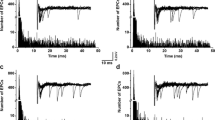Abstract
Two models of neurosecretion were evaluated in terms of their ability to predict the dependency of quantal content (m) on the frequency of repetitive stimulation of a lobster motoneuron. First, the hypothesis that neurosecretion is limited by a fixed number of release sites was tested by the fit of the distribution of m by uniform and nonuniform binomial statistics. The obtained release probabilities suggest that frequency facilitation can be due to activation of a group of sites with high release probabilities. However, the fit obtained using this model is not statistically significant due to a large number of fitting parameters. Second, the hypothesis that neurosecretion is limited by the rates of exchange between the releasable pool and the total store of quanta and that each stimulus enhances quantal mobilization was tested. Monte Carlo simulation was carried out in accordance with this model and reproduced the observed distribution of m with very few fitting parameters and therefore with a high level of significance (>0.1). This result demonstrates that mobilization of extra vesicles with each stimulus is a mechanism that allows a very accurate and parsimonious quantitative description of frequency facilitation.
Similar content being viewed by others
References
Augustine GJ, Charlton MP, Smith SJ (1987) Calcium action in synaptic transmitter release. Ann. Rev. Neurosci. 10:633–693.
Bennett MR, Robinson J (1990) Probabilistic secretion of quanta from nerve terminals at synaptic sites on muscle cells: Nonuniformity, autoinhibition and the binomial hypothesis. Proc. Rol. Lond. 239:329–358.
Bertram R, Sherman A, Stanley EF (1996) Single-domain/bound calcium hypothesis of transmitter release and facilitation. J. Neurophysiol. 75:1919–1931.
Blundon JA, Wright SN, Brodwick MS, Bittner GD (1993) Residual free calcium is not responsible for facilitation of neurotransmitter release. PNAS 90(20):9388–9392.
Bykhovskaia M, Hackett JT, Worden MK (1999) Asynchrony of quantal events in evoked multiquantal responses. J. Neurophysiol. 81:2234–2242.
Bykhovskaia M, Worden MK, Hackett JT (1996) An algorithm for high resolution detection of postsynaptic quantal events in extracellular records. J. Neurosci. Methods. 65:173–182.
Bykhovskaia M, Hackett JT, Worden MK (1999) Asynchrony of quantal events in evoked multiquantal responses indicates presynaptic quantal interaction. J. Neurophysiol. 81:2234–2242.
Cooper RL, Marin L, Atwood HL (1995) Synaptic differentiation of a single motor neuron: Conjoint definition of transmitter release, presynaptic calcium signals and ultrastructure. J. Neurosci. 15:4209–4222.
Cooper RL, Winslow JL, Govind CK, Atwood HL (1996) Synaptic structural complexity as a factor enhancing probability of calcium mediated transmitter release. J. Neurophysiol. 75:2451–2466.
Delaney KR, Tank DW (1994) A quantitative measurement of the dependence of short-term synaptic enhancement on presynaptic residual calcium. J. Neurosci. 14(10):5885–5902.
Dobrunz LE, Stevens CF (1997) Heterogeneity of release probability, facilitation, and depletion at central synapses. Neuron. 18:995–1008.
Elmqvist D, Quastel DMJ (1965) A quantitative study of end-plate potentials in isolated human muscle. J. Physiol. 178:505–529.
Hubbard JI (1963) Repetitive stimulation at the mammalian neuromuscular junction, and the mobilization of transmitter. J. Physiol. 169:641–662.
Jonson EW, Wernig A (1971) The binomial nature of transmitter release in the crayfish neuromuscular junction. J. Physiol. 218:757–767.
Kamiya H, Zucker RS (1994) Residual calcium and short-term synaptic plasticity. Nature 371:603–606.
Katz B (1969) The release of neural transmitter substances. Liverpool University Press, Liverpool.
Katz B, Miledi R (1968) The role of calcium in neuromuscular facilitation. J. Physiolol. 195:481–492.
Korn H, Mallet A, Triller A, Faber DS (1982) Transmission at a central inhibitory synapse. II. Quantal description of release, with a physical correlate for binomial n. J. Neurophysiol. 48:679–707.
Maeno T, Edwards C (1969) Neuromuscular facilitation with low-frequency stimulation and effects of some drugs. J. Neurophysiol. 32:785–791.
Mallart A, Martin AR (1967) An analysis of facilitation of transmitter release at the neuromuscular junction of a frog. J. Physiol. 193:679–694.
Redman S (1990) Quantal analysis of synaptic potentials in neurons of the central nervous system. Physiol. Rev. 70:165–198.
Rosenmund C, Stevens CF (1996) Definition of the readily releasable pool of vesicles at hippocampal synapses. Neuron. 16:1197–1207.
Schikorski T, Stevens CF (1997) Quantitative ultrastructural analysis of hippocampal excitatory synapses. J. Neurosci. 17(15): 5858–5867.
Smith BR, Wojtowicz JM, Atwood HL (1991) Maximum likelihood estimation of non-uniform transmitter release probabilities at the crayfish neuromuscular junction. J. Theor. Biol. 150:457–472.
Stevens CF, Wesseling JF (1998) Activity-dependent modulation of the rate at which synaptic vesicles become available to undergo exocytosis. Neuron. 21:415–424.
Stricker C, Redman S (1994) Statistical models of synaptic transmission evaluated using the expectation-maximization algorithm. Biophys. J. 67:656–670.
Vere-Jones D (1966) Simple stochastic models for the release of quanta of transmitter from a nerve terminal. Australian J. Stat. 8(2):53–63.
Wernig A (1972) Changes in statistical parameters during facilitation at the crayfish neuromuscular junction. J. Physiol. Lond. 226:751–759.
Winslow JL, Duffy SN, Charlton MP (1994) Homosynaptic facilitation of transmitter release in crayfish is not affected by mobile calcium chelators: Implications for the residual ionized calcium hypothesis from electrophysiological and computational analysis. J. Neurophysiol. 72:1769–1777.
Wojtowicz JM, Smith BR, Atwood HL (1991) Activity-dependent recruitment of silent synapses. Ann. New York Acad. Sci. 627:169–179.
Wojtowicz JM, Marin L, Atwood HL (1994) Activity-induced changes in synaptic release sites at the crayfish neuromuscular junction. J. Neurosci. 14:3688–3703.
Worden MK, Bykhovskaia M, Hackett JT (1997) Facilitation at the lobster neuromuscular junction: A stimulus-dependent mobilization model. J. Neurophysiol. 78:417–427.
Zucker RS (1973) Changes in the statistics of transmitter release during facilitation. J. Physiol. 229:787–810.
Author information
Authors and Affiliations
Rights and permissions
About this article
Cite this article
Bykhovskaia, M., Worden, M.K. & Hackett, J.T. Stochastic Modeling of Facilitated Neurosecretion. J Comput Neurosci 8, 113–126 (2000). https://doi.org/10.1023/A:1008917130947
Issue Date:
DOI: https://doi.org/10.1023/A:1008917130947




